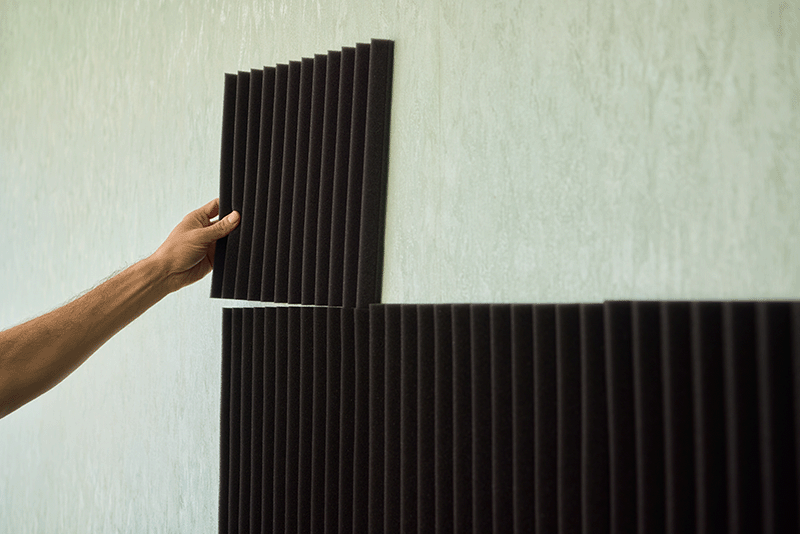Partner with Downstream

Sound has always played a role in how we experience a space—but in today’s hybrid and open-plan office environments, acoustic design isn’t a luxury. It’s a necessity. Whether you’re working on a law firm that needs pin-drop silence or a tech office that thrives on collaborative energy, poor acoustics can tank productivity and tenant satisfaction. In this post, we’ll break down what construction teams need to know when planning acoustic solutions for tenant improvement projects. From working with design teams to selecting materials that minimize reverberation, here’s how to build for better sound.

The shift toward open-concept layouts, remote work, and hot-desking environments has made acoustic control a core design requirement. Unlike traditional offices with private rooms and high-walled cubicles, many new layouts have fewer barriers to absorb or deflect sound.
Without proper sound management:
It’s not just about comfort—acoustics directly impact productivity, focus, and employee well-being.
The most effective acoustic strategies start before a single wall goes up. Construction teams should sync with architects, interior designers, and acoustical consultants during the early phases of planning.
Questions to ask:
Early collaboration helps avoid rework and ensures that the physical build aligns with the sound performance goalsset during design.
Many acoustic issues stem from hard, reflective surfaces—think concrete floors, glass partitions, and drywall. Choosing the right materials for floors, ceilings, and walls can significantly reduce unwanted noise.
Ceiling tiles with high NRC (Noise Reduction Coefficient) ratings absorb airborne sound and help control echo. These are especially useful in open-plan spaces or large meeting rooms.
Compared to polished concrete or tile, carpet reduces impact noise (footsteps, dropped items) and contributes to a quieter environment overall.
Wall treatments made of felt, foam, or mineral wool can reduce echo and improve clarity in meeting rooms, phone booths, and break areas.
Even the best materials won’t help if sound travels through gaps. Use acoustical sealants and gaskets to block airborne sound between walls, floors, and ceiling cavities.
Physical barriers and absorptive materials are only part of the solution. In open environments, sound masking systems(white noise machines) can fill in ambient sound and reduce speech intelligibility—making it harder to overhear conversations and easier to focus.
Installation typically involves:
These systems are often deployed in tandem with other acoustic strategies and should be planned for during the MEP coordination phase.
For an in-depth look at sound masking technology, Work Design Magazine provides a great overview of best practices in office environments.
Mechanical systems can be a major source of background noise. Coordinate with HVAC teams to:
Where privacy is essential, install wall partitions with STC (Sound Transmission Class) ratings of 45 or higher. This typically involves:
Don’t overlook door hardware and glass partitions. Use solid-core doors with acoustic seals and laminated glass with STC ratings to ensure privacy in conference rooms or executive offices.
Some tenants may require acoustic commissioning or post-construction verification. Factor in testing services or retain consultants who can provide before-and-after assessments.
Even seasoned build teams can fall into these traps:
Check out Acoustical Society of America for technical definitions and resources on acoustic design standards.
When you’re racing to complete a tenant improvement project, you need the right equipment—and the right partner—to hit your acoustic goals on time and on budget.
At Downstream, we help GC teams and subcontractors rent everything they need to build smart: from drywall lifts and scaffolding to sound-insulated barriers and panel lifts. We also coordinate logistics, delivery, and return across your jobsite schedule, so you can stay focused on performance—not procurement.
Explore our marketplace and see why Downstream is the go-to equipment rental source for contractors working in high-performance commercial spaces.
Acoustic design isn’t just an architect’s job—it’s a critical piece of the construction puzzle. By understanding how sound behaves, collaborating early, and choosing the right materials, construction teams can turn even the busiest office into a place where people can think, speak, and thrive.
Need to hit a tenant’s noise spec on your next project? Start with the right plan—and the right gear.
-min.webp)
Quis nostrud exercitation ullamco laboris nisi ut aliquip ex ea commodo consequat. Duis aute irure dolor in voluptate.
